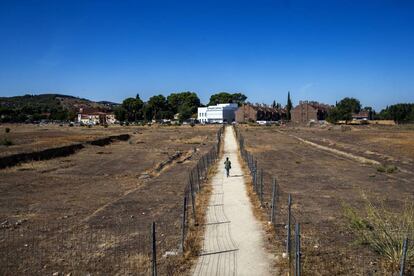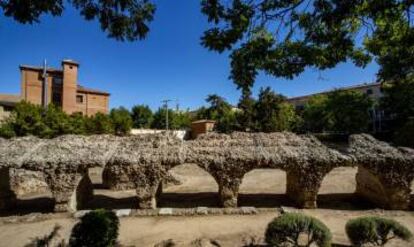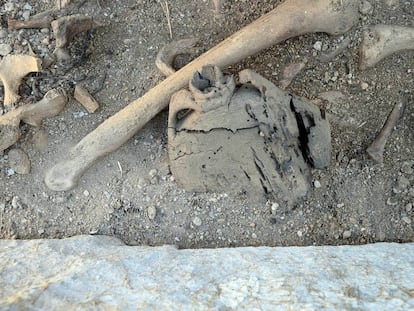Toledo’s Visigothic city under threat by real estate development
Once the capital of a powerful kingdom, the Vega Baja site includes remains from the Roman, medieval and Islamic eras that could soon make way for over 1,600 homes


When King Theudis decided to move the capital of the Visigothic kingdom to Toledo in the middle of the sixth century, he had no idea that modern urban planning laws would try to bury it under concrete.
Today, bricks and cement are threatening to destroy the remains of a city that once saw monarchs crowned masters of a kingdom that extended across almost the entire Spanish peninsula and southeastern France.
A citizen group named Toledo, Society, Heritage and Culture, which is made up of academics and local residents, has denounced plans to build 1,698 homes on the 220-hectare archaeological site.

Local authorities have strongly denied the accusation, insisting that “not a single [home] will be built on the site because it has been granted cultural heritage protection [BIC],” but they admit that developers do have the building rights to construct 1,500 homes, and that a Civil Guard barracks will be erected at one particular spot “because there is nothing under the ground there.”
Archaeologists and cultural heritage associations, however, are demanding that the entire site and the surrounding landscape be protected.
The impressive medieval city of Toledo sits on top of a hill. At its feet, by the banks of the Tagus River, lies the old Visigothic capital – an area that has been granted BIC status – the highest legal protection, making it untouchable – four times. Yet decade after decade, apartment blocks, official buildings and roads have been going up all around it, encroaching upon the ancient city. Luxury apartments with pools and spas are currently being built on the site known as Vega Baja, which was once home to a Roman circus. Now only the stands of the circus are visible from a park and nearby streets.
The historical value is incalculable. Why don’t they value this instead of just wanting to develop?
Archaeologist Juan Manuel Rojas
Under the 1986 general town planning scheme, 1,500 apartments were allowed to be built. The new 2007 zoning plan that replaced it maintained this provision, but it was annulled by the Supreme Court in 2017, meaning the 1986 plan has legal standing. According to Toledo City Hall, two modifications were made in 2017 to authorize the construction of a new Civil Guard barracks, but not homes. Despite this, local authorities recognize that developers have vested rights in Vega Baja, which was the suburbium, or suburbs, of the Visigothic capital. Toledo’s town-planning councilor, José Pablo Sabrido, asserts that “no building work will ever take place on top of the site, ever.” But the citizen group does not believe him.
“In this area, the Visigoths built the basilicas of Santa Leocadia, San Pedro and San Pablo, where at least eight Councils were held,” explains Juan Manuel Rojas, the archaeologist who led part of the excavation work, now discontinued for almost a decade. “In the early 1970s, [archaeologist] Pedro de Palol found the remains of the Santa Leocadia basilica [today Cristo de la Vega basilica] and, in 2001, we documented various structures of a large construction with 1.3-meter-thick walls. Now there is a clinic there,” he complains.
Antonio Zárate, a member of Toledo, Society, Heritage and Culture and of the Royal Toledo Foundation, is also concerned about the building activity. “The Roman circus didn’t end at the park fence. They say there is nothing beyond and that’s why they can build houses for rich people with views of the historic center. Just for them,” he complains. “Right here, where the Santa Eulalia church was, there are going to be 86 homes, another 300 where the circus was; on the other side of the Vega [Baja] they have built a boutique hotel [...] A school was built on top of the Temple of Mars. What are they doing?”

The archeological site is currently fenced off, but multiple traffic lanes with roundabouts cross through it and it is surrounded by homes that are several stories high. The remains of Visigothic, Roman and Muslim structures can be seen in the areas that were excavated by archaeologists years ago.
“There are few cities in Europe with such a collection of monumental structures. The historical value is incalculable. Why don’t they value this instead of just wanting to develop the land?,” asks Rojas. “It’s like having a painting by [Spanish artist Joaquín] Sorolla in the attic covered in dust and humidity, and not showing it. We have to think of the future generations.”
Araceli Pereda, the president of the heritage protection association Our Hispania, says they are going to demand an explanation from Toledo City Hall and from the regional government of Castilla-La Mancha for what is happening. “It was the capital of the Visigothic kingdom!” she exclaims. “We not only have to protect the BIC zone, we also have to protect its surroundings, which form part of the same city [...]. They are already building five-story apartments. It’s very alarming.”
English version by Melissa Kitson.









































